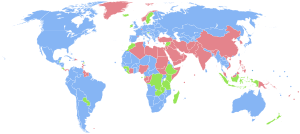
| Countries with more males than females. Countries with the same number of males and females (accounting that the ratio has 3 significant figures, i.e., 1.00 males to 1.00 females). Countries with more females than males. No data |
A sex ratio is the ratio of males to females in a population. As explained by Fisher's principle, for evolutionary reasons this is typically about 1:1 in species which reproduce sexually.[2][3] However, many species deviate from an even sex ratio, either periodically or permanently. Examples include parthenogenic and androgenetic[4] species, periodically mating organisms such as aphids, some eusocial wasps, bees, ants, and termites.[5]
The human sex ratio is of particular interest to anthropologists and demographers. In human societies, sex ratios at birth may be considerably skewed by factors such as the age of mother at birth[6] and by sex-selective abortion and infanticide. Exposure to pesticides and other environmental contaminants may be a significant contributing factor as well.[7] As of 2024, the global sex ratio at birth is estimated at 107 boys to 100 girls (1,000 boys per 934 girls).[8] By old age, the sex ratio reverses, with 81 older men for every 100 older women; across all ages, the global population is nearly balanced, with 101 males for every 100 females.[8]
- ^ Data from the CIA World Factbook [1]. Map compiled in 2021, data from 2020.
- ^ Fisher RA (1930). The Genetical Theory of Natural Selection. Oxford: Clarendon Press. pp. 141–143 – via Internet Archive.
- ^ Hamilton WD (April 1967). "Extraordinary sex ratios. A sex-ratio theory for sex linkage and inbreeding has new implications in cytogenetics and entomology". Science. 156 (3774): 477–488. Bibcode:1967Sci...156..477H. doi:10.1126/science.156.3774.477. JSTOR 1721222. PMID 6021675.
- ^ Schwander T, Oldroyd BP (28 Sep 2008). "Androgenesis: where males hijack eggs to clone themselves".
- ^ Kobayashi K, Hasegawa E, Yamamoto Y, Kawatsu K, Vargo EL, Yoshimura J, et al. (2013). "Sex ratio biases in termites provide evidence for kin selection". Nature Communications. 4: 2048. Bibcode:2013NatCo...4.2048K. doi:10.1038/ncomms3048. hdl:2123/11211. PMID 23807025.
- ^ "Trend Analysis of the sex Ratio at Birth in the United States" (PDF). U.S. Department of Health and Human Services, National Center for Health Statistics.
- ^ Davis DL, Gottlieb MB, Stampnitzky JR (April 1998). "Reduced ratio of male to female births in several industrial countries: a sentinel health indicator?". JAMA. 279 (13): 1018–1023. doi:10.1001/jama.279.13.1018. PMID 9533502.
- ^ a b "Field Listing—Sex ratio". CIA Factbook. The Central Intelligence Agency of the United States. Retrieved 2024-04-18. (2023 estimates)